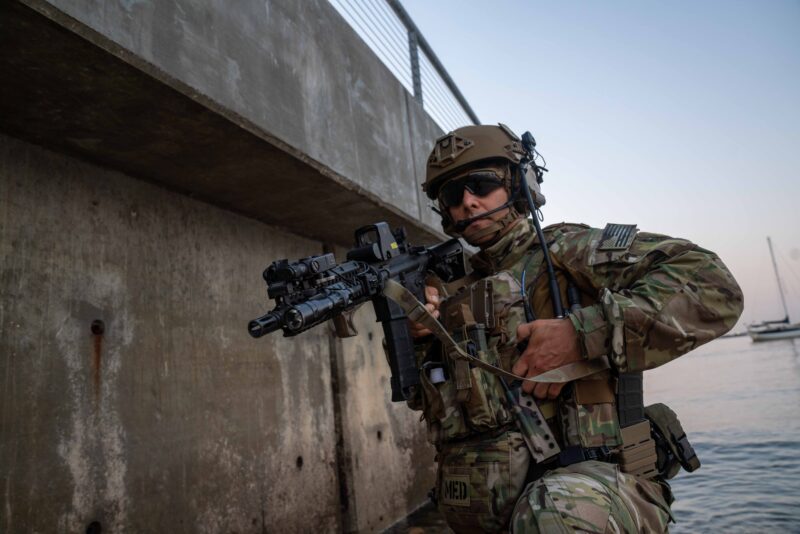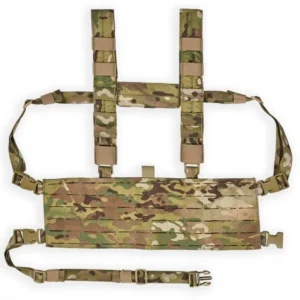Laser Cutting vs Traditional MOLLE: Key Differences

MOLLE (Modular Lightweight Load-carrying Equipment) systems are now considered the standard for tactical gear, providing unmatched customization and modularity. Years ago, the classic MOLLE webbing was well-suited for military personnel, law enforcement officers, and outdoor enthusiasts.
However, as manufacturing technologies improved, laser cutting emerged as a revolutionary alternative, offering notable benefits and unique challenges compared to traditional methods. Let’s examine the advantages and disadvantages of both approaches to determine which system best suits your needs. Upgrade your tactical gear with the MCR1 Laser Cut Chest Rig!
What is Laser Cut MOLLE?
Laser-cut MOLLE is the method of cutting nylon fabric with high-power lasers to form attachment points for module pouches and attachments. The molle laser cutting process enables the creation of more complex designs, allowing the fabric to achieve a streamlined, low-profile look without compromising strength and durability.
What are the Features of Laser Cut MOLLE?

Laser-cut MOLLE is gaining popularity due to its clean, rugged, and low-profile design. The following is a closer examination of the features that differentiate it from standard MOLLE systems.
1. Precision Cutting for Cleaner Lines
Laser cutting provides accurate, clean cuts in the fabric, resulting in a neat MOLLE system. In contrast to sewn MOLLE, which can fray or exhibit irregular stitching, laser-cut systems retain a clean look over the years.
2. Less Weight and Bulk
Laser-cut MOLLE often employs a lighter material than standard webbing. This creates a stronger, more compact construction that does not sacrifice strength. Gear utilizing laser-cut MOLLE, such as the MCR1 Chest Rig, offers durability and usability while maintaining a reduced total weight.
3. Improved Durability
Laser cutting does not involve sewing through the material, which compromises it in some areas. The technique maintains the material’s integrity, making it more durable against wear and tear, particularly under prolonged stress. Additionally, laser-cut systems are less prone to fraying, thereby extending their lifespan.
4. Low-Profile Design
Laser-cut MOLLE platforms, such as the Chase Tactical MCR1, lie flat against the body and feature a low-profile design. This is best for users who need to reduce bulk, particularly in tactical or concealed-carry applications.
What is Traditional MOLLE?

Classic MOLLE systems have been the backbone of tactical equipment for decades. Constructed by sewing nylon webbing onto fabric, classic MOLLE systems are extremely durable but have distinct attributes when compared to laser-cut MOLLE.
What are the Features of Classic MOLLE?
Classic MOLLE systems are utilized and relied upon by military personnel worldwide. Although newer systems offer some advancements, classic MOLLE remains a preferred choice among some users.
1. More Versatile Attachment Options
Conventional MOLLE features horizontal webbing that supports a high degree of modular attachment variability, such as pouches, holsters, and utility equipment. The webbing design also accommodates moving around accessories with ease, making it very adaptable.
2. Increased Structural Strength
Since standard MOLLE is constructed by sewing strong nylon webbing to the material, it has inherent strength and can hold heavy loads. The webbing that is stitched provides extra support at stress points, making it perfect for people who carry heavy gear.
3. Proven Durability in Harsh Conditions
Although laser-cut MOLLE is gaining popularity for its lightweight, accurate construction, conventional MOLLE systems are typically more durable in harsh conditions. The extra webbing layers provide increased durability, particularly under harsh conditions, making it the go-to for military personnel in combat roles.
4. Bulkier, but Reliable
Whereas classic MOLLE systems are heavier and more bulky because of the webbing, this bulk typically adds additional durability and toughness. It’s not necessarily the most sleek choice, but it provides proven functionality that’s hard to top in harsh environments.
Laser Cut MOLLE vs. Traditional MOLLE
Both systems have advantages, depending on what you value most in your equipment. Let’s compare for a more in-depth discussion:
| Feature | Laser Cut MOLLE | Traditional MOLLE |
| Manufacturing Process | Uses high-powered lasers to cut nylon fabric precisely | Sewn webbing attached to nylon fabric through stitching |
| Weight | Lighter and more compact | Heavier and bulkier due to extra webbing layers |
| Durability | More resistant to fraying, enhanced resistance to wear and tear | Extremely durable in rugged environments, ideal for heavy-duty load-bearing |
| Attachment Strength | Moderate, strong, but less reinforcement in high-stress areas | Higher attachment strength due to stitched webbing, suitable for heavy loads |
| Cost | Slightly more expensive due to the laser cutting process | Generally, more affordable due to a simpler manufacturing process |
| Maintenance | Easier to maintain, no risk of stitching fraying | Requires more maintenance, as stitching can wear over time, potentially leading to fraying |
| Best for | Lightweight, low-profile, and modern tactical setups | Heavy-duty, versatile use in demanding environments like military operations |
Conclusion
Both traditional and laser-cut MOLLE systems provide excellent benefits. Laser-cut MOLLE excels at delivering a cutting-edge, minimalist, and lightweight system that suits individuals who value efficiency and streamlining. Traditional MOLLE, however, is a dependable and rugged system for those who need additional ruggedness and adaptability. The best option comes down to your personal preference and the needs of your gear setup. Whether you’re opting for a streamlined chest rig or a more robust, customizable platform, both systems offer unique benefits for tactical enthusiasts.
Frequently Asked Questions
Is laser-cut MOLLE stronger than traditional MOLLE?
While both systems are designed to be durable, laser-cut MOLLE typically offers a lighter, more precise cut that doesn’t compromise on strength. However, traditional MOLLE has the advantage of overall structural reinforcement due to its sewn webbing.
Can I put pouches on both laser-cut and regular MOLLE?
Yes! Both platforms are made to be modular and will support a variety of pouches and attachments. However, regular MOLLE may have a slightly more solid attachment due to the stitching on the webbing.
Which is better for tactical purposes, laser-cut or regular MOLLE?
It varies with your requirements. If you need a low-profile and lightweight system, laser-cut MOLLE is the best option. However, if you require greater sturdiness and flexibility to carry heavy loads, a standard MOLLE would be a better choice.
Is laser-cut MOLLE as heavy as standard MOLLE?
Although laser-cut MOLLE can support heavy loads, standard MOLLE tends to offer stronger structural integrity due to its additional layers of webbing. If you will be carrying extremely heavy gear, standard MOLLE might be a better bet.
How can I maintain the condition of my laser-cut MOLLE gear?
Laser-cut MOLLE equipment is less maintenance-intensive than standard MOLLE equipment, as there is no risk of stitching fraying. But as with any tactical gear, periodic cleaning and inspection for damage are advised.

